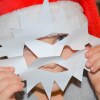The Countdown’s On: 4 Ways to Use Playful Math on New Year’s Eve

It was 11:59 a.m. on Dec. 31, and my two preschool-aged children were excited to be counting down to our family’s “Noon Year’s Eve.” Knowing full well that staying up until midnight would cause a day of exhaustion on Jan. 1st, we decided to celebrate mid-day and count down until the clock struck noon. “Three, two, one … Happy New Year!” we shouted as my daughters blew bubbles and we looked at the clock.
While the New Year holiday can be exciting, the idea of time, days and years can be an abstract thought for young children. We often find ourselves using phrases like, “You will be seeing Grandma in four sleeps,” or, “We wash our hands before lunch,” to help them conceptualize the passage of time.
Thankfully, the New Year’s holiday is a great time to support these developing math concepts. Research tells us that breaking down time into personal experiences helps children develop a sense of schedules, timing and early math skills. As we count backward, observe clocks and reference calendars during the year-end, we can help our little ones practice counting, sequencing and tallying skills.
Here are five opportunities to highlight early math in your New Year’s Eve celebration:
1. Make a New Year’s Eve Clock. While we often tell time from digital clocks on our phones, ovens, or cars, knowing how to read an analog clock is an important skill. Practice with this PBS KIDS’ paper plate clock activity. Point out the hour hand and minute hand and practice counting by 5’s with "Peg + Cat." Use the paper clock to count down to 12:00 p.m. on New Year’s Eve. You can also hang it on your refrigerator or door throughout the year to help transition your child from one activity to the next.
2. Make a New Year’s Paper Chain. If your child has a hard time understanding days, use paper links to visually represent the passing of days counting down to New Year’s Day. Encourage your child to write the numbers from one to 10 on the paper rings. Take one off the chain each morning and count the remaining links. You might consider adding a wish or goal for 2021 to each paper link.
3. Count backward from 10 to one. As PBS KIDS writes, “counting forward and backward by 1’s lays the foundation for addition and subtraction.” Let your little one in on the fun as we count down to the stroke of 12:00. Practice counting backward from 10 to one with this "Curious George" activity in the days leading up to New Year’s. For extra support, you might consider writing the numbers on Post-its to stick on a nearby wall. Allow your little one to remove each of them one at a time until you get to one.
4. Create a family calendar. Discuss the number of days in a year and how we tally them by months and weeks. Using construction paper and a ruler, create seven columns and label each at the top with a day of the week. Then, help your little one draw your family routines or activities under each day. For example, you might use this to help illustrate which day they play soccer, which day their grandparent picks them up from school, or which day is family game night. Build on this weekly calendar by introducing monthly and yearly calendars.
5. Discuss the terms “before” and “after.” Use New Year’s Eve as a reference point for discussing upcoming and past family events. Help children sequence events by considering if the event is before New Year’s Eve or after. Use this concept when talking about number order.
Whether your family celebrates at the stroke of midnight or noon just before lunch, use New Year’s Eve traditions to boost early math skills. Help your little one practice these skills, and next December, celebrate all the accomplishments when New Year’s comes rolling around again.
Resources
- Miller, Susan. Ages & Stages: How Children Develop a Sense of Time



